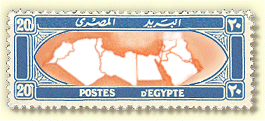pages 614-625
When Italy joined with Germany and declared war on Britain and France in June 1940, Egypt and the Suez Canal came under immediate threat. Libya on the western border was under Italian control and Italian East Africa (Eritrea and Ethiopia) lay at the southern border
of the Sudan. A see-sawing war in the Western Desert began with British troops entering Libya in June 1940, followed by an Italian invasion into Egypt in September, and the British again entering Libya in December. In April 1941 the combined Axis forces were on the Egyptian frontier and mounted an all-out campaign to take Alexandria. It was not until November 1942 that all Axis forces were cleared from Egypt and were chased back across Libya.
Military forces of Britain, Australia, New Zealand, South Africa, and the United States were in Egypt during the war, as well as expatriate army groups of Free French and Polish allegiance, and even some Belgian and Greek troops. Each of these (except possibly the last) had its own army post offices with distinctive postmarks. The postal markings and locations of the British army post have been covered by Crouch and Hill28a and more completely and in detail by Gould and Proud28b British Naval Mails have been surveyed by
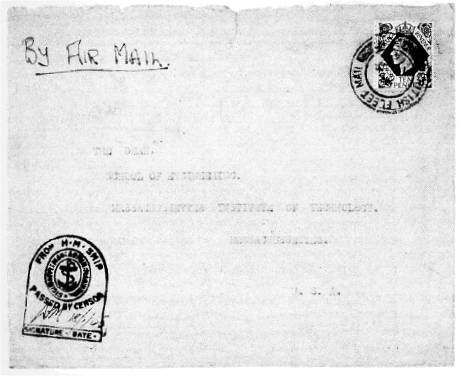
Fig. 27 Cover cancelled BRITISH FLEET MAIL.
Goldup29. Such mail was generally cancelled on arrival in Great Britain, but double-ring circular date-stamps (Fig. 27) inscribed BRITISH FLEET MAIL and a number were in use in 1944-49. Number 4 was assigned to Port Said, 18 to Port Tewfik (later to Minden, Germany), 36 to Alexandria, and 39 to Cairo. A volume by Benians30 devoted to the EGYPT/POSTAGE PREPAID date-stamps introduced in 1941 contains much information on the army postal services of all the Empire. Much information on the New Zealand forces is to be found in the books by Startup and Proud and by Collins and Watt, already cited24. The US APOs in Egypt have been described in articles31 and are listed in books32 The postal service of the Indian Army has been thoroughly described by Virk33 and by Proud34. A general survey of the military postal markings used by the Empire forces in Egypt has been published by G. Boulad35, and an account of the Polish field post office in Egypt by Markoff36. Information on the Free French military post offices in Egypt is included in a book by Deloste37 and an article by G. Boulad38. The subject is enormous, the published literature is massive, and it is not feasible to cover the subject in any detail in just a part of one chapter. The following notes therefore provide only a superficial glimpse and the cited works should be consulted for more complete and precise information.
Egypt Postage Prepaid (EPP)
Date-stamps with this inscription were used from May 1st 1941 to as late as 1945 by the military forces of Britain and the Dominions, with numbers that were randomly assigned and did not correspond to any identifying number of a military unit. These date-stamps were adopted in an agreement with the Egyptian Government, according to which troops could use the stamps of their own countries and the respective forces would assume the task of handling the military mails. There were four sub-types of handstamp and two major types of machine cancellation, one having wavy lines, the other having a slogan, IT PAYS TO LEND, with cog-wheels (Fig. 28). The numbers were sometimes moved from one unit to another, although the post offices were essentially stationary. A large amount of information associating particular numbers with military units at different dates can be found in the books cited, which also illustrate the different types.
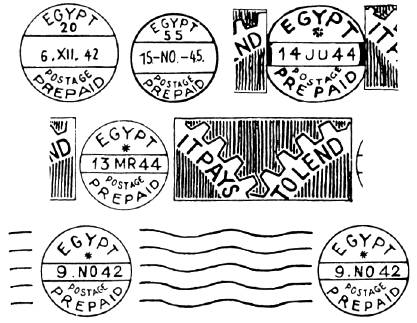
Fig. 28 "Egypt Postage Prepaid" cancellations.
Army Signals
Large, double-circle date-stamps inscribed ARMY SIGNALS around the top are occasionally seen on covers not only of World War II, but also of earlier conflicts back as far as the reconquest of the Sudan. Large letters (usually severe abbreviations) at the ends of the date bands identify the place of use (if one is clever!). These date-stamps were used in an official courier service, outside the regular mails, for urgent official communications39 (for example, across Cairo from, say, Maadi to Heliopolis, but in some cases for much longer distances), and were not intended to be used for personal correspondence (Fig. 29). Nevertheless, the date-stamps are sometimes seen on personal mail, as a rare exception. I have not seen an Army Signals date-stamp cancelling Egyptian stamps, but I have seen it on Sudanese stamps. Stamps would have been required only if the letter was to be handed over to a regular army post office for onward transmission.
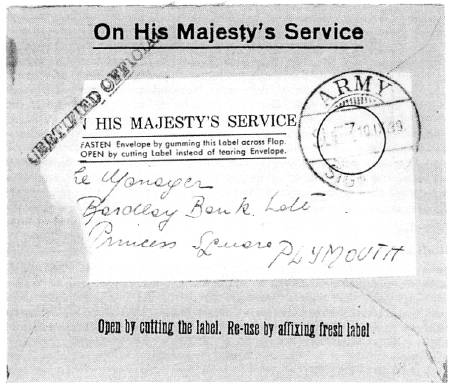
Fig. 29 An official cover sent by Army Signals at Suez.
British Forces
The various named APOs, FPOs and BPOs in use prior to the war were changed to numbers in the 600 series in 1939 (E. 601 to E. 615) (Fig. 30). In the first part of 1941 these date-stamps were transferred to Indian or Australian FPOs. During most of 1940 letters were franked with the 10m. ARMY POST stamps (almost exclusively that of King Farouk), used alone for surface letters, or in multiple or combination with Egyptian stamps for air mail. The cancellations were the 600-series date-stamps or the standard FIELD POST OFFICE date-stamps with curved bars and number. When the Egypt Postage Prepaid date-stamps were introduced they became the principal means of cancelling the mail of the British Forces, except for the mobile FPOs at the front, which used the standard type of FIELD POST OFFICE / number date-stamps. These date-stamps were used extensively to cancel Egyptian stamps when they were required on letters, for the most part to pay for air mail and especially to countries other than Britain and the Dominions. Their use continued into the 1950s.The Royal Air Force developed its own postal service, but it was little used in Egypt. A circular date-stamp inscribed RAAF/BASE P.O. No. 5 / 3 JY 43 / M.E. has been seen on a cover apparently originating in Cairo (RAF censor no. 560).
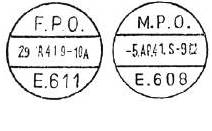 Until November 1940 postage to Britain was paid either with Army Post stamps alone, or in combination with Egyptian stamps. After that date letters by surface mail were postage free, but air mail and registration charges had to be paid with stamps. From May 1st 1941 postage was paid with British stamps, although residual Army Post stamps were occasionally used (they are rare with EPP cancellations). British stamps used included the ½d. and 1d. King Edward VIII and all values of the King George VI series up to 10/-, including both the light and dark colours of the low values. Values above 1/- are quite scarce with EPP cancellations. The 2d. vermilion postal card is also found with EPP cancellations.
Until November 1940 postage to Britain was paid either with Army Post stamps alone, or in combination with Egyptian stamps. After that date letters by surface mail were postage free, but air mail and registration charges had to be paid with stamps. From May 1st 1941 postage was paid with British stamps, although residual Army Post stamps were occasionally used (they are rare with EPP cancellations). British stamps used included the ½d. and 1d. King Edward VIII and all values of the King George VI series up to 10/-, including both the light and dark colours of the low values. Values above 1/- are quite scarce with EPP cancellations. The 2d. vermilion postal card is also found with EPP cancellations.
Registration cost 3d. Letters over 2oz. cost 3½d. up to 3oz., thereafter 1d. per ounce. Air mail letters were charged 10d. for the first half ounce to Britain or South Africa and 9d. to Australia and New Zealand; each additional half ounce cost 1/8d. Air letter sheets cost 3d. The air mail concession rate of 40m. (= 10d.) had actually been in effect from October 28th 1939.
Australian Forces
The first contingent of Australian troops arrived in Egypt in February 1940. Their mail was handled in essentially the same way as that of the British forces, utilizing the kinds of date-stamps then in use. With the introduction of the EPP date-stamps, Australian stamps could be used, although Australian troops also used British stamps extensively. Perhaps for that reason Australian stamps are not so easy to find with EPP cancellations. The stamps that have been seen are of the 1937 series: 1d., 2d., 3d., 6d., 9d., 1/-, the 9d. being the commonest.
New Zealand Forces
The first New Zealand troops disembarked at Port Tewfiq on February 12th 1940 and promptly proceeded to Cairo and Alexandria; military post offices were opened at Maadi (Cairo) and Alexandria. A variety of date-stamps with explicit indication N.Z., or the easily recognized code K.W., were used (Fig. 31). (The explanation of K.W. as derived from `Kiwi' is not confirmed in official records and it has been stated that the choice was more or less arbitrary, the letters being chosen because they were composed of straight lines and were thus easier to cut.) When the EPP date-stamps were put in use, New Zealand stamps began to be used in Egypt in substantial quantities and next to those of Great Britain are the easiest to find. The variety of stamps was much larger than the Australian and included the second pictorial series (2d., 2½d., 3d., 4d., 5d., 6d., 8d., 9d., 1/-, 2/-, 3/-), the King George VI portrait stamps (½d. green or brown, 1d. red or green, 1½d. red or brown, 3d., 1d. on ½d. green, 2d. on 1½d. brown), and the Centennial set (½d. to 1/-). Official records state that small quantities of the arms-design postal-fiscal stamps were also sent. The 9d. values are the commonest, but combinations of other values were frequently used to make up the rate. Some New Zealand postal stationery has been seen used in Egypt, but it was probably brought privately and not actually sold in Egypt.
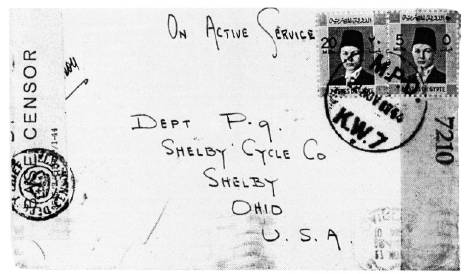
Fig. 31 New Zealand forces date-stamp K.W.7 used in November 1944.
Indian Forces
The first of the Indian troops arrived at Port Tewfiq on August 17th 1939 and quickly moved up the Canal to settle in at Fayid, bringing with them the date-stamp for FPO 19, of typical Indian design (Fig. 32). In October the contingent moved to Mena Camp. Army Post stamps were used until the arrangement of May 1st 1941 permitted Indian stamps to be used. However, by that time, a large part of the Indian contingent had been sent to the Sudan along with the several FPO date-stamps ((see Fig. 22) that had eventually been put into use40. When used in Egypt, Indian stamps were generally cancelled with EPP date-stamps. The stamps that have been seen are: King George VI (1937, 1a., 3as.; 1941-43 3as., 4as., 8as.); Officials (KGV 1a.3p.; KGVI 3p., 1a., 2as., 4as.). The most common is the 8as., which paid the air mail rate.
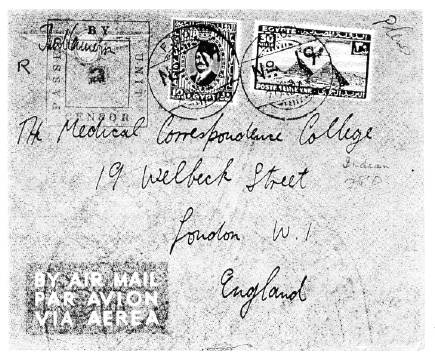
Fig. 32 Indian F.P.O. 19 date-stamp.
South African Forces
Troops from southern Africa included those from Southern Rhodesia and the Union of South Africa and probably some individuals from colonial entities such as Swaziland or Nyasaland. South African stamps with EPP cancellations are nearly as plentiful as those of New Zealand and include a wide variety: 1933-37 pictorials (1d., 2d., 3d., 4d., 6d., 2/6);1941-42 large War Effort series (all values); 1942-43 bantam War Effort series (all values); 1945 Victory. Combinations with British stamps to make up the commonest rate, 10d., are not exceptional (Fig. 33).
A few stamps of Southern Rhodesia have been recorded with FPP cancellations (1935-41 2d., 3d. 'Falls'; 1937 KGVI. 1/2d, 1d., 11/2d., 4d., 9d., 10d.).
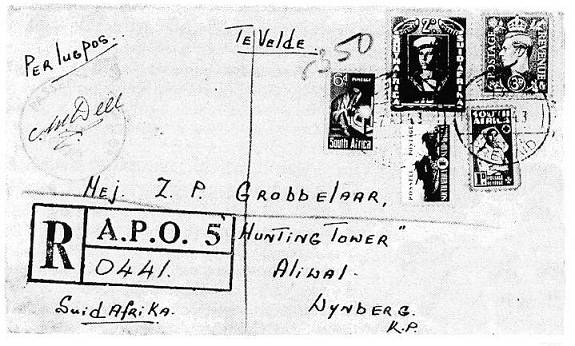
Fig. 33 Combination of Union of South Africa and British stamps on a registered letter.
Canadian Forces.
A drawing of a mysterious date-stamp inscribed CANADIAN ARMY / IN EGYPT / 11/JU-43 / B.V.H., without explanation, has been illustrated41. There appears to be no official record of a Canadian contingent in Egypt, but there may have been some Canadian officers loaned to the British Army.
Other Stamps
Troops moving from one theatre to another often brought a few stamps with them and in some cases stamps were sent to them from home (occasionally, without doubt, with philatelic inspiration). Among the stamps that have been seen with EPP cancellations are: Aden (1939 KGVI 1a., 3as., 4as., 8as.); Bahrain (1938-41 overprints 3as., 8as.); Malta (1938-46 Id., 2d., 41/2d.); Palestine (15m.); M.E.F. overprint on GB 5d. (Harrison); and, curiously, Lebanon (1940 5pi. green), and United States (6¢ red air mail, 6¢ orange air mail envelope).
Egyptian stamps used with EPP cancellations could in principle include all of those current at the time, but some of them would have been of little use. Those actually recorded include: King Fuad (4m., 13m., 40m., 100m.); Farouk Boy King (1 to 10m., 15m., 20m.); 1939 high values (30m., 40m., 100m.); Farouk Marshal 10m., Air Mails (8m., 10m., 20m., 30m. blue & brown, 30m. green, 100m.); Express 20m.; Official 5m.; Princess Ferial 5m. Some additional Egyptian stamps are known used with FPO cancellations in the periods before and after the duration of the EPP date-stamps.
There is little doubt that additions to the foregoing lists of stamps of other countries used in Egypt during World War 11 can be made; those that are listed here are those that have been reported by Benians and those that I have seen.
Free French Forces
A small number of Free French troops, derived from expatriates and French army units stationed outside France prior to the German occupation, were in Egypt38, and were provided with their own date-stamps42 (Fig. 34). Number 4 was assigned to Cairo and number 5 to Alexandria, but one device has the identification blacked out, presumably for security. There were two distinct types, one of which shows the cross of Lorraine above the date band and F.F.L. below it, and the other is smaller, has no date band (the date is in two lines), no cross of Lorraine, and has F.F.L. within the curve at the bottom. The latter may have been used in Lebanon and Syria; I have seen it on cover addressed to Port Said addition-ally struck with the first type dated four days afterwards. I have seen only Egyptian stamps cancelled with these hand-stamps. There is also a small rectangular handstamp, F.F.L. / POSTE aux ARMEES / VE 17, struck on the face of a stampless cover, which may be an authorization for free franking and may not have been applied in Egypt. The Free French mails appear to have been handled through the British postal services; they were subject to Free French censorship (cross of Lorraine handstamp) as well as British.

Fig 34.
Covers are also known from the French warships detained at Alexandria in 1940-4343.
Polish Forces
A Polish Corps was formed in Kazakhstan and later moved to Libya via Iran and Egypt. A Polish Brigade was also raised in Syria. The Polish forces had their own date-stamps, POCZTA POLOWA (Field Post), which saw some use in Egypt (Fig. 35); I have seen numbers 103 and 115 cancelling Egyptian stamps, and Bureau 101 is stated to have been assigned to Egypt also36. Covers from Polish troops have also been seen with the stamps cancelled by an EPP date-stamp (no. 21 seen). The censor mark and sealing label used by the Polish Forces are described in Chapter XL.
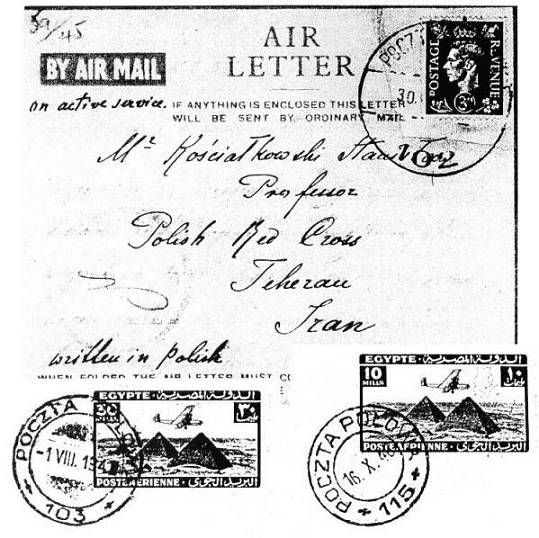
Fig. 35 Use of Polish Field Post cancellations in Egypt (the Polish censor mark, OCENSUROWANO / EXAMINED BY CENSOR, is faintly struck at lower left of the cover).
Belgian Forces
Covers exist with a rectangular date-stamp inscribed POSTE MILITAIRE / CONGO BELGE (1943), addressed to Alexandria and censored only in Egypt, endorsed "on active service" and backstamped with the EPP date-stamp of a date too close to the date of dispatch to have come from Congo. It may have been that the Congo date-stamp was brought to Egypt and pressed into service for use by a small Belgian corps. (Belgian forces participated in the campaign in the Sudan.)
Italian and German Forces
At the end of November 1940 there was a brief incursion by Italian troops into the region of Buqbuq (northwest coast), withdrawn by mid-December (U.P.M. nos. 303, 304) The major invasion of Egypt from Libya began at the end of June 1942, leading to a push to El Alamein. Several Italian Uffzio Postale Militare operated in the region from Sollum, at the Libyan border, to El Dabaa. They were withdrawn to Libya in the first week of November 1942. The Italian Division of General DiNisio invested Siwa Oasis in July 1942 (Chapter XLI). U.P.M. 58 has been cited, but Cecchi44b cites U.P.M. 136. Neither Italian nor Egyptian stamps are known used by this force; the troops sent their letters without stamps44a. Cecchi44b lists the following U.P.M.s as having been seen involved in the El Alamein campaign: 31, 54, 56, 58, 96, 109, 132, 133, 221, 260, 600.Information about the German Feldpost locations and postmarks may be found in Projekt Himmelblau44c and publications by Gericke44d and by Kesselstatt44e Feldpostnummer 06677, Kenn-Nr. 538, is listed as having been used at Mersa Matruh July-October 1942.
United States Forces32
The United States Army Air Force 98th Bombardment Group was sent to Egypt in November 1942 and was engaged in supply and air support as well as bombing missions as far afield as Ploesti, Romania; the Group later moved to Libya and then Italy. Army Post Offices operated independently of the other postal services in Egypt and used distinctive date-stamps (Fig. 35). Surface mail was free to military personnel, but attached civilians were required to pay postage of 5c per ounce with United States stamps. Air mail was at the domestic rate of 6¢ per half ounce for all and was paid either with US stamps, usually the 6c red air mail stamp, or the 6¢ orange embossed air mail envelope (small size with and without red and blue border, no. 10 size with border). By custom, the date-stamp part was struck on the envelope and only the obliterating bars on the stamp (Fig. 36). The stamps seen used in Egypt are: Presidential 11/2c, 2c, 3¢, 5¢, 6¢; War Effort 1¢, N, 3c; air mail U red; Northwest Territory Sesquicentennial 3¢; Kentucky Statehood Sesquicentennial 34. The Egypt Boy King 6m. is known used from APO 683 on a cover to Palestine, an address to which US stamps would not have been valid.
Identification of a cover as having been sent from Egypt depends on the APO number and the date. Although the date-stamps usually have the APO number at the bottom or inside the dial, at some times the number was deleted for short-sighted security reasons (the APO number generally appeared in the return address in the upper left corner anyway). The return-address APO number does not always correspond to that of the Fig. 36 United States postmarks used in Egypt, and a cover posted at US APO 678, Heliopolis, charged 6c postage due because the weight exceeded ½oz. date-stamp because mailing addresses were independent of the office of dispatch. The port of embarkation for mail to APOs in Egypt was New York. The list that follows gives known locations and dates (mostly from official records). Some of the APOs listed for Cairo probably never actually functioned in Egypt, but were kept there in reserve.
| APO 485 | Kabrit | 12 JA 43-JN 43 |
| APO 486 | Deversoir | 12 JA 43 |
| Heliopolis | 1 MR 45 |
| | (ceased 31 OC 45) |
| APO 498 | Camp Huckstep | 14OC43-1MY44 |
| APO 523 | Cairo | JA 46-15 MY 46 |
| APO 535 | Cairo | JA 46-15 MY 46 |
| APO 616 | Cairo | 20 NO 42 |
| Camp Huckstep | 1 OC 43 |
| Cairo | DE 46 |
| APO 626 | Heliopolis | 19 JA 43-MY 43 |
| APO 678 | Heliopolis | 7 NO 42-22 OC 45 |
| Camp Huckstep | 1943 |
| HO, ME Service Command | |
| APO 680 | same as 535 | |
| APO 681 | | 20 NO 42-AP 43 |
| 376th Bomber Group | |
| APO 683 | | 20 NO 42-31 JA 43 |
| APO 684 | Camp Ataka | 3 OC 43 |
| Camp Huckstep | 16 JA 44 |
| Alexandria | 16 SE 46 |
| (ceased DE 46) | |
| APO 685 | Cairo | 16 JA 44-30 JY 44 |
| 1081st Engineer Utility Detachment | |
| | |
| APO 686 | Suez | 30 OC 43 |
| Port Tewfik | 27 OC 43 |
| Camp Ataka | 16 JA 44 |
| Cairo | 1 MR 45 |
| APO 696 | Cairo | 23 DE 42-24 NO 43 |
| APO 785 | Alexandria | 30 NO 42 |
| HO, ME Service Command | |
| APO 786 | Alexandria | 5 DE 42 |
| Gambut | 4 JA 43-MY 43 |
| APO 787 | Cairo+ | 21 JA 43-6 OC 45 |
| HQ, Africa-ME Theatre | |
| APO 788 | Heliopolis* | 3 OC 43-10 OC 45 |
| APO 795, 797, 799 | same as 535 | |
| APO 814 | Cairo | 25 JN 42-12 AU 42 |
| APO 816 | Cairo | JA -MR 46 |
| APO 1222 | | 10 NO 42-30 JA 43 |
| 343rd Bomber Squadron | |
| APO 1223 | | 1 FE 43-10 FE 43 |
| 24th Station Hospital | |
| APO 1224 | | 1 NO 42-1 NO 43 |
| Camp Huckstep, Cairo | |
| APO 3405 | Cairo? (return address only | |
| no date-stamp seen) | |
| 8th Base Post Office | -- 43 -- NO 45 |
Gambut 4 JA 43-21 AP 43 (no identifiable postmark known)
+ Heliopolis (Camp Russell Huckstep). + Deversoir Field? * John Payne Field.
Forte and Helbock32c rate all United States World War II APO covers according to scarcity and demand and suggest retail prices. On a scarcity scale of 1 to 10, the ratings assigned are: 2 - 696, 788; 4 - 616, 785; 5 - 678, 683, 786, 787; 6 - 486, 681; 7 - 485, 498, 626, 684, 686, 1222, 1223, 1224; 8 - 685, 814. The demand factor for Egypt, 2, is surprisingly low.
The use of other APO numbers and U.S. Navy FPO date-stamps at the United States Embassy in the post-war years is described in Chapter XLII.
References
| 32a. | G. Cosentim and N. Gruenzner, eds., United States Numbered Military Post Offices. Assignments and Locations 1941-1994, The Military Postal History Society, 1994. |
| 32b. | J. Shaffer, Geographic Locations of U.S. APO's 1941-1978, War Cover Club, 1979 , 1985 (earlier editions by A.J. Tripp). |
| 32. | J. Forte and R.W. Helbock, A Price Guide to U.S. A.P.O. Cancels of the Second World War, La Posta Publications, Lake Oswego, OR, 1996. |
| 33. | D.S. Virk, Indian Army Post Offices in the Second World War, The Army Postal Service Association, New Delhi, 1982. |
| 34. | E.B. Proud, History of the Indian Army Postal Service, Vol. III, Proud Bailey Co. Ltd., Heathfield, E. Sussex, 1984(?), Chapters 3 and 12-14. |
| 35. | G. Boulad, L'OP No. 75, 190-200 (July 1951), No. 76, 229-39 (Oct. 1951), No. 79, 454-6 (July 1952). |
| 36. | A. Markoff, L'OP No. 61, 249-51 (Jan. 1948); see also R. Wagner, History of the Polish Army Postal Service. Middle East and Italy 1940-48, self-published, Hove, Sussex, 1992. |
| 37. | C. Deloste, Histoire Postale et Militaire de la Deuxieme Guerre Mondiale, Editions Echangiste Universel, Bischwiller, 1969. |
| 38. | G. Boulad, L'OP No. 86, 374-9 (Apr. 1954). |
| 39. | E. Jagger, Philately VI (1), 176-7 (Jan./Feb. 1956); reprinted in FPHS No. 58, 71-2 (Nov./Dec. 1962). |
| 40. | S. Stobbs, FPHS No. 32, 7-10 (July/Aug. 1958), No. 33, 1-5 (Sep./Oct. 1958), No. 38, 71-7 (July/Aug. 1959). |
| 41. | A. Lewandowski, WCCB 1960 (No. 20, June), 244. |
| 42. | C. Deloste, Histoire Postale et Militaire de la Deuxieme Guerre Mondiale, Editions Echangiste Universel, Bischwiller, 1969; Keys, AP 81 (2), 137 (1967). |
| 43. | A. Winter, QC VIII (6), 67-70 (whole no.90, June 1974); L'OP No. 127, 336-47 (Oct. 1973). |
| 44a. | S.D. Tchilinghirian and R. Bernardelli, Stamps of ltaly Used Abroad, Part Two, Harris Publications, London, 1964. p. 137.
| | 44b. | B.C.-A. Cecchi, La Posta Militare Italiana nella Seconda Guerra Mondiale, Rome, 1991.
| | 44c. | Projekt Himmelblau. |
| 44d. | B. Gericke, Die deutsche Feldpost im zweiten Weltkrieg, Archiv füf deutsche Postgeschichte, Heft 1, 1971. |
| 44e. | F. Kesselstatt, Die Tunis Päckchenmarke and die Palmenstempe l, Handbuch der Briefmarkenkunde, Heft 49, 1978. |
|
